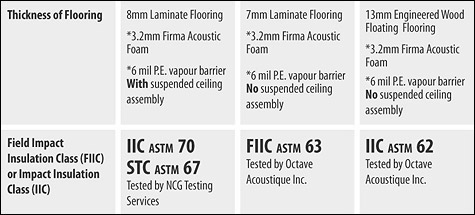The following are frequently asked questions and answers about Acoustic Underlayments.
Why do I need sound insulation and if so, what kind of underlayment do I need? I live in a condo in a high-rise building.
When living in a multi-unit residence, sound barriers are required to make your living space quieter from the noises from other units. When an owner of this type of unit wants to install hardwood in their home, an underlayment with acoustical properties is normally required to reduce the impact sound transmission to the unit underneath.
What does IIC rating mean?
Impact Insulation Class:
An IIC rating is a measure of a reduction in impact sound transferring from a floor surface to the room underneath. The higher the number, the less the sound is transferred. (e.g. foot traffic, dropping items on the floor, etc.)
What does STC rating mean?
Sound Transmission Class:
An STC rating is a measure of a reduction in airborne sound transferring through walls, floors, ceilings, etc. The higher the number, the less the sound is transferred. (e.g. talking, music, etc.)
How does the underlayment affect the IIC and STC ratings?
Very differently. Read the following article:
What’s That Sound?
Building codes typically specify two types of sound-control ratings:
IIC (Impact Insulation Class) and STC (Sound Transmission Class). A rating of 50 for each generally is a standard requirement. The IIC relates to sound transmitted as a result of impact on a surface – footsteps on a floor, for example. The STC relates to airborne sounds, such as voices and music. Sound-control underlayments often carry an STC rating, as well as an IIC rating. How ever, says Ann Wicander of WE Cork, flooring products really have a substantial effect only on impact sounds. “The underlayment really will not affect STC much,” Wicander says. “It really confuses people. The STC or airborne sound is really affected almost solely by the structure itself.”
Source: Hardwood Floors, The Magazine of the National Wood Flooring Association – Issue: June/July 2002 page 93
What is the difference between IIC rating and FIIC rating?
IIC ratings are found by performing the test in a laboratory, and a FIIC rating is found by performing the test out on the field using an actual building. FIIC ratings are closer to the true values of the actual performance of the underlayment used in your home.
I found an underlayment that has a 75 IIC rating and was told it is the best on the market today. Is this true?
This may not be true for your building. Different types of subfloor-ceiling assemblies will result in different IIC ratings. For example, IIC ratings found using plywood over wood joist system versus a concrete slab, and even different thicknesses of slabs, can have significant differences. Adding a suspended (drop) ceiling assembly, made with special construction materials, attached under the subfloor system during the testing can also increase the IIC rating. This kind of system is some times used in commercial buildings. Also, changing the special construction materials, thickness of flooring or imbedding steel rebar into the concrete slab can alter the IIC/FIIC rating results. You need to find out if the IIC rating test was done with the same subfloor/ceiling assembly as yours. And if not, ask if they can supply you with the rating that matches your building. The company you purchase from should be able to provide a copy of the test results and how the test was done if you need a copy for your strata. (For an example, see Firma® Foam FIIC/IIC results below.)

How do I know that I’m buying the correct underlayment for my building?
Most Stratas have guidelines to select an acceptable acoustic underlayment for your building and you should contact them prior to installation of your new hardwood flooring to get an approval.
I would like to install an engineered wood using a glue-down installation method using an acoustic underlayment. Can I do this?
No. In recent years, environmental issues have driven glue manufactures to produce a product that is environmentally safe. The formulations have changed and some glues will react with foam underlayment and the bond will be compromised. Also, some underlayment can be torn apart because it is not strong enough to hold the hardwood flooring in place during normal expansion and contraction of wood planks. For a glue down application we recommend a cork underlayment only.
What is the industry standard IIC rating?
“Impact Noise. Section 9.11 has no requirements for control of impact noise transmission. Footstep and other impacts can cause severe annoyance in multi-family residences. Builders concerned about quality and reducing occupant complaint will ensure that floors are designed to minimize impact transmission. A recommended criterion is that bare floors (tested with out carpet) should achieve an impact insulation class (IIC) of 55. Some lightweight floors that satisfy this requirement may still cause complaints about low frequency impact noise transmission. Adding carpet to a floor will always increase the IIC rating but will not necessarily reduce low frequency noise transmission. Good footstep noise rejection requires fairly heavy floor slabs or floating floors. Impact noise requirements are being considered for inclusion in future versions of the Code.” Source: British Columbia Building Code (Canada) – section: Appendix A-9.11.1.1. – pg 529
We recommend using an underlayment with an FIIC rating of 60 or more of the combined flooring and subfloor-ceiling assembly.
Can I install solid wood flooring over acoustic underlayment?
You cannot nail down solid wood flooring directly over and acoustic underlayment. When you nail through an underlayment and into the subfloor, the impact sound transmission travels through the nails into the subfloor resulting in a loss in the acoustical value of the underlayment. If you want to install solid wood flooring and use and acoustical underlayment, the best way to do it is install the acoustic underlayment under a floating subfloor. And then, install the solid hardwood flooring on the floating subfloor using the manufactures recommendations. The flooring height clearance should be taken into consideration.








